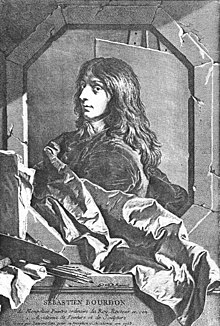Sébastien Bourdon

Sébastien Bourdon (born February 2, 1616 in Montpellier , † May 8, 1671 in Paris ) was a French painter .
After Guilly, he was one of the most brilliant painters in France in the 17th century, and achieved a high reputation in his time. He led an adventurous life because of his unsteady character. Due to his very good image memory, he also had the ability to draw from pictures of other painters once seen, which also allowed him to try out different styles, so that his work is inconsistent. Therefore, according to Guilly, despite his talent, he is not counted among the painters of the first rank in French painting of his time.
Life
Bourdon first learned the trade of glassmaker from his father in Montpellier . When he was seven, an uncle took him to Paris, where he was apprenticed to a painter Barthélemy. At the age of fourteen he painted a ceiling painting in a castle near Bordeaux and then went to Toulouse, where he received no commissions. For lack of money, he was enlisted in the military . His captain sympathized with him and regularly gave him leave to paint, and thanks to the intercession of patrons he was released. In 1634 he came to Rome , where he painted paintings in the style of Claude Lorrain , Andrea Sacchi , Pieter van Laer (Bamboccio) and other well-known artists for an art dealer, as well as his own pictures in the Bambocciade style. He also had some success, but had to flee in 1637, as he was denounced as a Protestant at the Inquisition by the French painter Rieux, with whom he had had a dispute. He went to Paris, where he had such great success with hunting and battle pictures and landscape paintings in the Italian style that the goldsmiths' guild commissioned him with their May picture in 1643 (the crucifixion of St. Peter for the Notre-Dame church , meanwhile in the Louvre, now Notre Dame again). In 1648 he was a founding member of the Académie royale de peinture et de sculpture and professor there. He married the sister of the miniature painter Duguernier, a colleague at the academy. In 1652 he went to Sweden as court painter to Queen Christina I - there was one of his main works, the equestrian painting of Queen Christine (now Madrid). After the latter's abdication, he returned to Paris, was again a professor at the academy and, from 1655, its rector. In 1657 he went to his hometown Montpellier, where he painted the case of Simon Magus for the cathedral chapter. Due to an argument about the picture with another painter, whom he slapped, he left Montpellier and went back to Paris, where he died in 1671.
He painted many ceiling and wall paintings in Paris, for example in the Parliament, the Chamber of Accounts, the Hotel de Toulouse, the Hotel de Bretonvilliers (legend of the Phaeton and others, today only drafts are preserved), the collegiate church of St. Benoit. Most of it has not survived in the original.
His later work in France was influenced by Nicolas Poussin , for example in his landscapes, and also by the Le Nain brothers . He also left etchings and engravings.
Bourdon ran a large studio in which students were also trained. These students also include Nicolas Loir (who painted for the decoration of the Tuileries), Fricquet de Vaurose (anatomy professor at the Academy of Arts - he also made copperplate engravings after works by Bourdon) and Pierre Mosnier .
Works
exhibition
- 2014: Focal point Rome, Sébastien Bourdon's Munich lime kiln , Alte Pinakothek , Munich
literature
- R. Guilly: Kindlers Malereilexikon, dtv 1982
- Ch.Ponson-Hailhe: Sébastien Bourdon, sa vie et son oeuvre , Paris 1883
Web links
Individual evidence
| personal data | |
|---|---|
| SURNAME | Bourdon, Sebastien |
| BRIEF DESCRIPTION | French painter |
| DATE OF BIRTH | February 2, 1616 |
| PLACE OF BIRTH | Montpellier |
| DATE OF DEATH | May 8, 1671 |
| Place of death | Paris |









